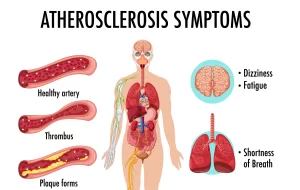 Atherosclerosis is a common yet potentially serious condition characterized by the narrowing and hardening of arteries due to the accumulation of fatty deposits.
Atherosclerosis is a common yet potentially serious condition characterized by the narrowing and hardening of arteries due to the accumulation of fatty deposits.
As this condition progresses silently over time, it is essential to be aware of its symptoms, which may indicate the need for early intervention and prevention.
Today, we will explore the key signs that will help you understand the symptoms of atherosclerosis better.
The Silent Intruder
Atherosclerosis often develops gradually without presenting any noticeable symptoms in its early stages. The gradual accumulation of plaque inside the arteries leads to reduced blood flow, hindering the delivery of oxygen and nutrients to various organs and tissues. This silent progression is what makes understanding its symptoms so crucial.
Chest Pain or Angina
One of the most common symptoms of atherosclerosis is angina, characterized by chest pain or discomfort.
Angina occurs when the heart muscle does not receive enough blood due to narrowed coronary arteries. The pain may feel like pressure, squeezing, or burning and is usually triggered by physical exertion or emotional stress.
Shortness of Breath
As atherosclerosis restricts blood flow to the lungs, it can lead to shortness of breath, especially during physical activities. This symptom often accompanies angina and should not be ignored, as it may indicate significant cardiovascular issues.
Leg Pain and Weakness
Atherosclerosis affecting the arteries in the legs can lead to a condition called peripheral artery disease (PAD). PAD can cause pain, cramping, or weakness in the legs during physical activity, which improves with rest. Recognizing these symptoms is crucial for early detection and management of atherosclerosis.
Erectile Dysfunction (ED)
Men with atherosclerosis may experience difficulties with achieving or maintaining an erection. The narrowing of blood vessels in the pelvic area can impair blood flow to the genitals, contributing to ED. Addressing this symptom proactively can help identify underlying cardiovascular concerns.
Heart Attack
In advanced stages, atherosclerosis can lead to the formation of blood clots that can block blood flow entirely, resulting in a heart attack.
Symptoms of a heart attack include:
- intense chest pain,
- pain radiating to the arms, back, neck, or jaw,
- cold sweat,
- nausea,
- lightheadedness.
Immediate medical attention is critical when experiencing these symptoms.
Atherosclerosis is a stealthy condition that can pose significant health risks if left untreated. Understanding its symptoms empowers us to take proactive steps to prevent its progression and the potential complications associated with it.
Regular medical check-ups, a heart-healthy lifestyle, and managing risk factors such as high cholesterol, high blood pressure, and smoking can go a long way in reducing the impact of atherosclerosis and safeguarding our cardiovascular health.
Remember, early detection and timely intervention can be life-saving, so stay vigilant and prioritize your heart health.
Picture Credit: Freepik
